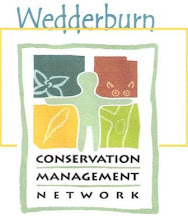
The continuing damp weather has created interesting changes in the local vegetation. Green rock ferns are prolific in places and the small white flowers of early Nancy plants are out now. The flat scented sundews are almost overshadowed by the large white flowers they are currently displaying. Orchids are beginning to emerge now, particularly the Dwarf Greenhood.
An increasing variety of wattles are now flowering. In parts of the Wychitella nature conservation reserve stands of Bent Leaf wattle are flowering well, the widespread golden wattle is also very visible at present.
The native twining parasite plant Coarse Dodder – laurel (locally known as snoddy gobble) is increasing in mass and vigour at this time of year. Examples of this can be seen on trees lining the Calder highway.
Echidna activity seems to have increased judging by the amount of disturbed soil and ant nests in some forest areas. Rabbits also continue to disturb the ground. The increase in moisture has encouraged the proliferation of many weeds such as oxalis, bridal creeper and Patterson’s curse.
Observers of nature can expect to see different wildlife at different times of day. Late afternoon wanders in the bush have resulted in sightings of the Australian owlet Nightjar. Early morning and late afternoon are the times that kangaroos and wallabies are most commonly sighted. This month the WCMN has been involved with setting up sites to monitor kangaroo numbers. The sites are in bushland and open country.
There is a sense that spring is not far away with many plants getting ready to flower and birds increasingly active around nesting areas. Another member of our group reported sightings of forty different species of birds over a period of two days including: a hooded robin, a flame robin, a collared sparrowhawk, a tawny crowned honeyeater, a white fronted honeyeater, a black chinned honeyeater and a brown treecreeper. Keep your eyes open for nature’s indications of the changes in season and weather.
An increasing variety of wattles are now flowering. In parts of the Wychitella nature conservation reserve stands of Bent Leaf wattle are flowering well, the widespread golden wattle is also very visible at present.
The native twining parasite plant Coarse Dodder – laurel (locally known as snoddy gobble) is increasing in mass and vigour at this time of year. Examples of this can be seen on trees lining the Calder highway.
Echidna activity seems to have increased judging by the amount of disturbed soil and ant nests in some forest areas. Rabbits also continue to disturb the ground. The increase in moisture has encouraged the proliferation of many weeds such as oxalis, bridal creeper and Patterson’s curse.
Observers of nature can expect to see different wildlife at different times of day. Late afternoon wanders in the bush have resulted in sightings of the Australian owlet Nightjar. Early morning and late afternoon are the times that kangaroos and wallabies are most commonly sighted. This month the WCMN has been involved with setting up sites to monitor kangaroo numbers. The sites are in bushland and open country.
There is a sense that spring is not far away with many plants getting ready to flower and birds increasingly active around nesting areas. Another member of our group reported sightings of forty different species of birds over a period of two days including: a hooded robin, a flame robin, a collared sparrowhawk, a tawny crowned honeyeater, a white fronted honeyeater, a black chinned honeyeater and a brown treecreeper. Keep your eyes open for nature’s indications of the changes in season and weather.
Article by the `Wedderburn Observers`

No comments:
Post a Comment